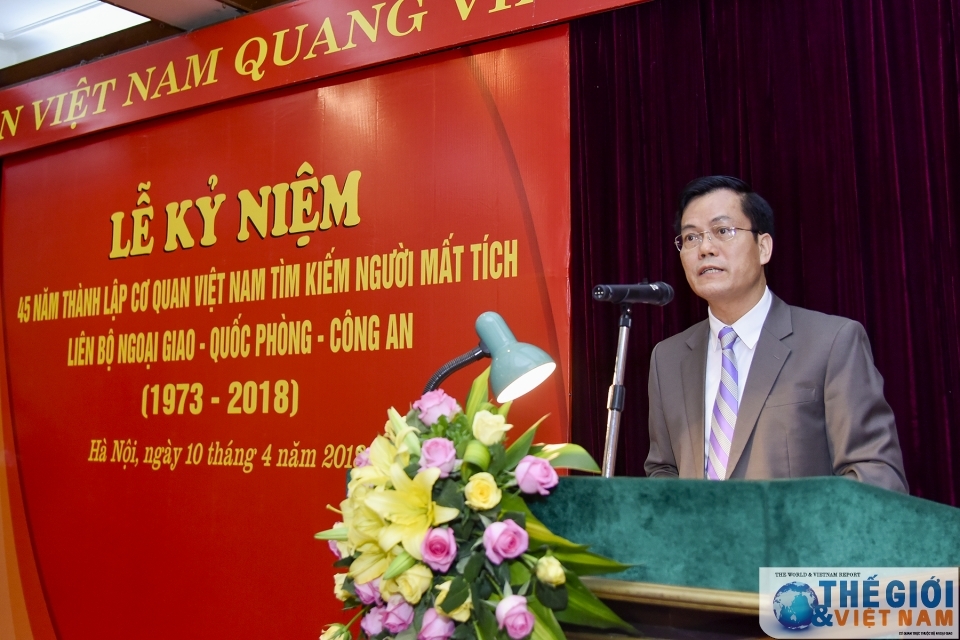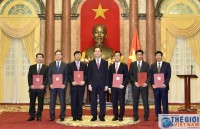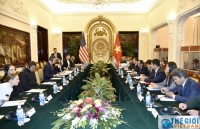
A testament to Vietnam’s peace-loving tradition and tolerance
Latest
| TIN LIÊN QUAN | |
| Repatriation of U.S. servicemen's remains | |
In this interview for The World and Viet Nam Report, Deputy Foreign Minister Ha Kim Ngoc emphasized the importance of the MIA issue in the Vietnam – US relations, pointing out the conducive factors as well as challenges for MIA affairs in the near future. "The two sides will continue to work closely to overcome these challenges," he affirmed.
 |
| Deputy Foreign Minister Ha Kim Ngoc. (Photo: Nguyen Hong) |
Could you specify how Viet Nam's cooperation in helping the US search for the MIA has contributed to promoting the two countries’ bilateral relations?
It can be said that the history of the Vietnam – U.S. relations, from former enemies to friends and comprehensive partners as at present, has always been associated with Vietnam’s great cooperative efforts to help the U.S. search for servicemen missing-in-action (MIA). Over the past 45 years, the MIA searching activity has played an important role in fostering bilateral relations in all areas, as shown in the following points:
First of all, the cooperation on resolving the MIA issue has created a bridge, the first channel of contact between the two countries' political circles, bringing them closer together and contributing to demonstrating Viet Nam’s goodwill and cooperation to the American political community and people. Immediately after the Paris Peace Accord - the Agreement on Ending the War and Restoring Peace in Vietnam was signed, on February 9, 1973, the late Prime Minister Pham Van Dong signed the Decision No.34/TTg, establishing the Vietnamese Office for Seeking Missing Persons (VNOSMP) to implement Article 8b of the Agreement. From 1973 to 1988, we overcame the difficulties and deprivation in all aspects, to collect and conduct 24 repatriation rounds, handing over to the United States a total of 302 sets of remains related to U.S. servicemen. Since the early 1980s, the two governments have established a channel for resolving the war legacy, in particular the search for MIA in Vietnam. In August 1987, Deputy Chairman of the Council of Ministers, Minister of Foreign Affairs Nguyen Co Thach and Gen. John Vessey, Special Emissary of President Ronald Reagan, signed an agreement on the cooperation to address humanitarian issues of mutual interest. Joint MIA searches were organized starting in 1988. In July 1991, Viet Nam made an approval for the U.S. to establish a MIA Office in Ha Noi, being the first permanent mission of the United States in Hanoi following the war. Between 1991 and 1993, we provided to the U.S. a large volume of document pertaining to MIA, and approved many rounds of investigation on information pertaining to surviving Americans in Viet Nam, including sudden requests. On this basis, the U.S. Congress Select Committee on POW/MIA Affairs had a report concluding that there is no evidence that there are any American MIA alive in Viet Nam.
It can be said that the MIA issue has always been present in most major events of the Viet Nam – U.S. relations over the past decades, from the U.S. considering lifting the embargo, the establishment of the Liaison Office, the establishment of diplomatic relations, to the waiver of the Jackson – Vanik Act and the Bilateral Trade Agreement negotiation.
| The U.S. will continue to work with Viet Nam in the effort to search for information related to Vietnamese personnel missing in the war, said President Donald Trump during the meeting with President Tran Dai Quang in November 2017. |
Second, certainly no other area of Viet Nam – U.S. bilateral cooperation has come close to the same scale, scope and length of time as MIA affairs. In the 30 years of joint operation alone, from 1988 to 2018, the two sides have together undertaken 130 joint operations and 144 repatriations with a total of 975 sets of remains, among which the US side has identified 720.
Presently the two sides are still working closely to implement different forms of operations, the most remarkable among which are: (i) unilateral operations that the Vietnamese side undertakes, that includes perusal of files, investigation and excavation, all of which are highly effective, sometimes even resulting in outright recovery of remains; (ii) offshore investigation using Vietnamese materiel, equipment and experts that meets the requirement of the US side; and (iii) the fact that we have opened up many sites that previously limited foreigner access, thus enabling joint search operations between the two sides.
MIA cooperation has expressed the peace-loving, diplomatic and tolerant tradition of the Vietnamese people. This has dispelled the suspicion of a portion of the US political elite regarding our goodwill. For this Viet Nam has been thanked and highly appreciated by American politicians including both the Administration and the Congress, the Association of MIA families, and the American veteran organizations, who consider our cooperation in MIA affairs exemplary. On this basis, MIA cooperation has created a conducive atmosphere for the development of bilateral cooperation in all areas. In particular, the U.S. side has become more responsible in assisting Viet Nam in addressing war legacy issues, including the search for and interment of the remains of Vietnamese war martyrs, the removal of UXO, Agent Orange/dioxin decontamination, and assistance for war victims.
In your opinion, what are the factors conducive to and challenges for MIA affairs in the future?
There will be many factors conducive to MIA activities in the future, but there are also many difficulties and challenges.
The first major facilitating factor is the humane policy of the Party and State as well as the peace-loving, diplomatic and tolerant tradition of the Vietnamese people: the willingness to set aside the past and look towards the future. This is in spite of the fact that the Vietnamese people and country themselves are still suffering from manifold war wounds.
| US Ambassador to Viet Nam H.E. Daniel Kritenbrink: The U.S. will continue to cooperate in the search for missing personnel, UXO and detoxification of dioxin-contaminated areas. |
The second factor is the excellent development of the Viet Nam – United States comprehensive partnership. The understanding between the politicians and peoples of the two countries is steadily increasing. The United States is providing Viet Nam with increasingly substantive assistance in addressing war legacy issues in Viet Nam. These factors help to garner greater support from the Vietnamese people and war veterans regarding MIA activities.
The third factor is the fact that after more than half a century of MIA operations, the Vietnamese staff responsible for this area has grown and matured. They are not only capable of fulfilling their duties, but have also proactively and creatively recommended suitable initiatives to improve the effectiveness of this work.
Yet the greatest challenge remaining is time. The war came to an end a long time ago. Many incidents took place fifty to sixty years in the past. The available source of witnesses and information has gradually faded away. As I often say to American partners: “A veteran who passed away is akin to a library burned.” Many sites have been lost, or at risk of loss and changes due to weather and natural conditions as well as economic-social development. Remaining sites are mostly located in remote jungles or mountains or deep sea areas and are difficult or dangerous to approach.
Even so, it is my belief that the two sides will be able to work closely together to overcome all of these challenges; so that at the end of the day we can say, without burden and with pride, that we have done all that can be done in good faith to help the United States take stock of their MIA as adequately as is possible.
As you have shared, Viet Nam's cooperation in assisting the US's MIA affairs has contributed to the U.S. becoming more responsible in assisting Viet Nam in healing war wounds. What are the recent developments in the cooperation between Viet Nam and the U.S. in the dioxin remediation effort in Viet Nam? What are the plans between the two sides in the future to continue this work?
During the war in Viet Nam, the United States had used about 74 million liters of defoliant including those containing dioxin. The residue of this toxic substance remains in many localities in Viet Nam, major contamination points being the Bien Hoa airport, Da Nang airport and Phu Cat airport, along with other areas such as A So, A Luoi (Thua Thien – Hue province) and Sa Thay (Kon Tum province) among others. This causes serious and long-term socio-economic, environmental, health and psychological issues to Viet Nam and her people.
In response to the goodwill and full cooperation of Viet Nam in the MIA issue, and as a result of a more complete understanding of their responsibility regarding the war legacy in Viet Nam, the United States have become more active in assisting Viet Nam more concretely and effectively in Agent Orange/dioxin detoxification at these hot spots, in particular at the Da Nang airport. From 2006, the US Senate Finance Committee began recommending financing for dioxin detoxification in this area. In total the United States has spent some $130 million on this project. This project is now fundamentally complete, with 160,000 cubic meter of soil purified safely and effectively, thus meeting the national environmental standard. 29 hectares after purification was handed over on time to expand Da Nang airport for the APEC Economic Leaders' Week. This has helped ensure health safety for the people and benefited economic and social development in the city of Da Nang. The American side had also spent nearly $5 million on the detoxification of the Phu Cat airport.
In the upcoming future, one of the key projects of collaboration in healing war wounds between Viet Nam and the US shall be the commencement of dioxin detoxification at Bien Hoa airport. From 2013, the US side had sponsored for the assessment, studies and surveys into the contamination status in this area. These studies concluded in April 2016. It is expected that the total workload and budget for this project will be much greater than the project at Da Nang airport. In January 2018 the two sides has signed an MOU on dioxin remediation in the Bien Hoa airport area. I have every reason to believe the two sides will soon reach an agreement on the implementation of this key project.
Thank you very much, Mr. Deputy Minister!
By Trinh Quang Chinh
| The search for the remains of US MIAs during the war in Viet nam is a humanitarian activity between the governments of Viet Nam and the United States. From 1985, through the US Department of Defense POW and MIA Agency and its predecessors and the cooperation of VNOSMP, joint searches between the US and Viet Nam has found more than 800 remains of American personnel in Viet Nam and a total of 1,100 remains of American personnel across all countries related to the Viet Nam War. By April 2018, the Vietnamese side has completed a total of 143 transfers of remains of American personnel since 1973. Mrs. Fern Sumpter Winbush, Principal Deputy Director for the Defense POW/MIA Accounting Agency during the 4th Viet Nam – US Defense Policy Dialogue on 17 October 2017 in Washington D.C, stated that the United States holds in very high regard the Vietnamese side's cooperation and assistance in the MIA issue. She also expressed her sincere gratitude towards the Vietnamese Minister of Defense Ngo Xuan Lich for having recently transferred to the US side two highly reliable sets of files pertaining to MIA searches, as well as for enabling the two sides' joint search teams to operate effectively on the ground. The U.S. Ambassador to Viet Nam H.E. David Shear, after visiting an excavation site in Son La, remarked that it was through his visit that he was able to see the full extent of the hardship and complications of the MIA search, and further understand this humanitarian operation of the Vietnamese side. Mr. Ron Ward, casualty resolution specialist, Detachment 2 of the Joint POW/MIA Accounting Command stated that the goodwill of Viet Nam began at the governmental level, yet stemmed from the people, and that without the support of the Vietnamese people and veterans this affair would have been impossible. He also said the cooperation between the two sides was most excellent. Mdm. Mary Tarnowka, Consul-General of the United States in Ho Chi Minh City at the 143th transfer of remains on 15 April 2018 in Da Nang, said that the U.S. government thanked and highly appreciated the goodwill and humane spirit of the Vietnamese side, and reiterated that MIA cooperation between Viet Nam and the U.S. was exemplary among humanitarian cooperation. |
 | Vietnamese Office for Seeking Missing Persons marks 45th anniversary The Vietnamese Office for Seeking Missing Persons (VNOSMP) held a ceremony in Ha Noi on April 10 celebrating its 45th founding anniversary. |
 | President presents appointment decisions to new ambassadors President Tran Dai Quang presented appointment decisions to six ambassadors to foreign countries for 2018-2021 at a ceremony in Ha Noi on March 26. |
 | Vietnam, US talk political, security, defence matters Deputy Foreign Minister Ha Kim Ngoc and the US’s Principal Deputy Assistant Secretary of State for Political-Military Affairs Tina Kaidanow co-chaired the ninth Vietnam-US Political, ... |

















